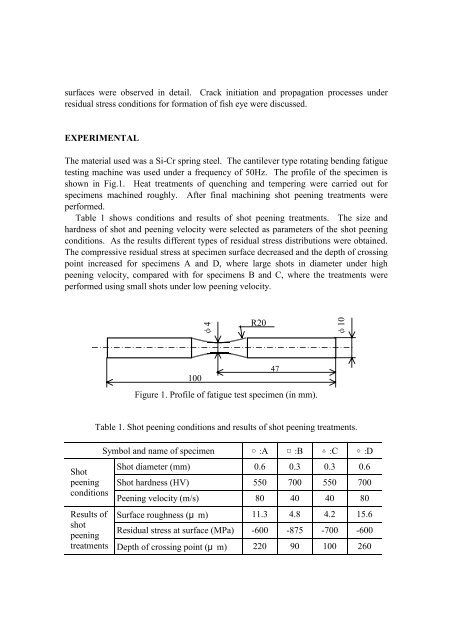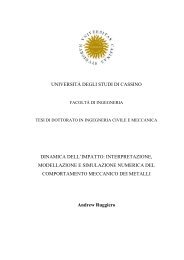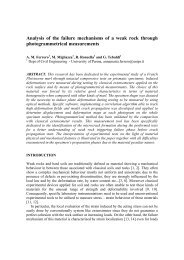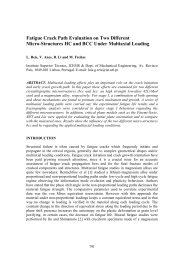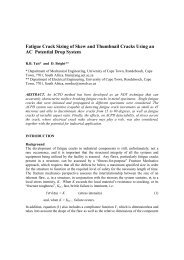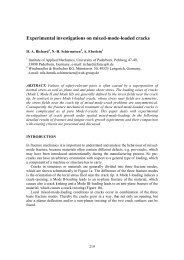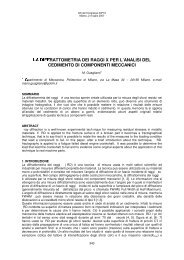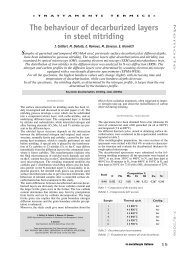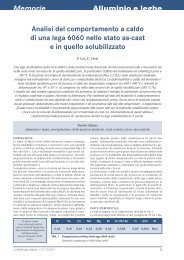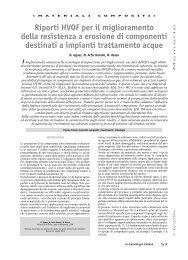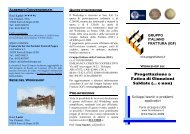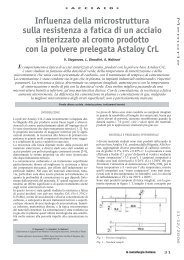Fatigue Crack Initiation and Propagation under Circumstances of ...
Fatigue Crack Initiation and Propagation under Circumstances of ...
Fatigue Crack Initiation and Propagation under Circumstances of ...
Create successful ePaper yourself
Turn your PDF publications into a flip-book with our unique Google optimized e-Paper software.
surfaces were observed in detail. <strong>Crack</strong> initiation <strong>and</strong> propagation processes <strong>under</strong><br />
residual stress conditions for formation <strong>of</strong> fish eye were discussed.<br />
EXPERIMENTAL<br />
The material used was a Si-Cr spring steel. The cantilever type rotating bending fatigue<br />
testing machine was used <strong>under</strong> a frequency <strong>of</strong> 50Hz. The pr<strong>of</strong>ile <strong>of</strong> the specimen is<br />
shown in Fig.1. Heat treatments <strong>of</strong> quenching <strong>and</strong> tempering were carried out for<br />
specimens machined roughly. After final machining shot peening treatments were<br />
performed.<br />
Table 1 shows conditions <strong>and</strong> results <strong>of</strong> shot peening treatments. The size <strong>and</strong><br />
hardness <strong>of</strong> shot <strong>and</strong> peening velocity were selected as parameters <strong>of</strong> the shot peening<br />
conditions. As the results different types <strong>of</strong> residual stress distributions were obtained.<br />
The compressive residual stress at specimen surface decreased <strong>and</strong> the depth <strong>of</strong> crossing<br />
point increased for specimens A <strong>and</strong> D, where large shots in diameter <strong>under</strong> high<br />
peening velocity, compared with for specimens B <strong>and</strong> C, where the treatments were<br />
performed using small shots <strong>under</strong> low peening velocity.<br />
4<br />
R20<br />
10<br />
100<br />
47<br />
Figure 1. Pr<strong>of</strong>ile <strong>of</strong> fatigue test specimen (in mm).<br />
Table 1. Shot peening conditions <strong>and</strong> results <strong>of</strong> shot peening treatments.<br />
Symbol <strong>and</strong> name <strong>of</strong> specimen :A :B :C :D<br />
<br />
Shot<br />
Shot diameter (mm) 0.6 0.3 0.3 0.6<br />
peening Shot hardness (HV) 550 700 550 700<br />
conditions<br />
<br />
Peening velocity (m/s) 80 40 40 80<br />
Results <strong>of</strong> Surface roughness ( m) 11.3 4.8 4.2 15.6<br />
shot<br />
<br />
peening<br />
Residual stress at surface (MPa) -600 -875 -700 -600<br />
treatments Depth <strong>of</strong> crossing point ( m) 220 90 100 260


